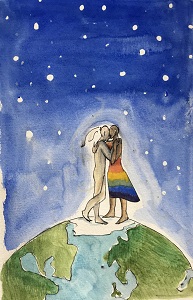All real living is meeting, all real meeting is tango
 People love to move together.
People love to move together.
Argentine tango is a really fun way to move with, and in response to, another person. We move to music, usually in the company of other dancing couples. If you watch any Argentine tango, I think you will be able to feel whether you are drawn to it or not. If you look closely, and ignore any flashy flicks and kicks, you might see that the dance is essentially a walking dance: the dancers walk forwards or backwards, or to the side. As a social dance, tango is danced because it is enjoyable and engaging, it not about performance. I hope the QTE videos show how much fun we have: here is a link to the few QTE videos we have on the Facebook group (you don’t need to join the group to watch them).
If you can walk, you can tango! You do have to be able to pay attention. Tango has been called ‘walking with attitude’, I think it’s ‘walking with awareness’ – awareness of yourself, of the other person, of everybody else in the room, and of the music. People often talk about tango as being a conversation. I think in the world that’s what we’re looking for – different ways to have a conversation, to connect really well with other people. As human beings we thrive with connection, and tango is just a fabulous way of connecting.
Why does Tango need queering?
Queer tango is about dancing Argentine tango in different ways. At its most simple, it is about dancing all roles and rejecting traditional gender stereotypes. What happens beyond that is up to the dancers. There is a place in queer tango for everyone.
To queer something is to reinterpret it, to question the traditional rules and patterns that currently exist. ‘Queer’ also explicitly references gender and sexuality, and hopefully speaks particularly to people who might feel excluded by tango’s more traditional gender roles. These meanings are both important in the context of Queer Tango.
Queer Tango Edinburgh beginner/mixed classes are a space where anyone who might like to try tango can explore roles and ways of dancing that open up the experience of this amazing dance.
It should be noted, if someone only wants to learn one role, to only interpret (follow) or to only suggest (lead), of course, they can do that. In the classes everyone will be invited to learn all roles of the dance, but nobody has to dance in any way they don’t want to, not even in practice. It is common for people to prefer one role over the other, but some dancers do both more or less equally. Some people practice both roles but only dance one when dancing socially. The point is to open up choices not to enforce new limitations.
Queer Tango is an international phenomenon. Different queer tango communities are more radical than others, and have different emphases. In Edinburgh, we seem to be a bit more questioning than many other QT groups. At QTE, we want to change the culture in several ways, not simply to enable LGBTIA+ people to fit into a traditional environment. To find out more about queer tango in the world, a good place to start is The Queer Tango Project, where you can download their excellent book of essays, poems and artwork and visit their Queer Tango Image Archive. On youtube you can find video of Queer Tango events from all over the world, from Buenos Aires to Ottawa and from Berlin to St Petersburg.
